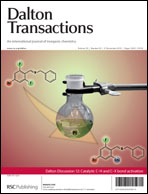Regioselective functionalization of iminophosphoranes through Pd-mediated C–H bond activation: C–C and C–X bond formation†‡
Abstract
The orthopalladation of iminophosphoranes [R3P![[double bond, length as m-dash]](https://www.rsc.org/images/entities/char_e001.gif) N–C10H7-1] (R3 = Ph31, p-Tol32, PhMe23, Ph2Me 4, N–C10H7-1 =
N–C10H7-1] (R3 = Ph31, p-Tol32, PhMe23, Ph2Me 4, N–C10H7-1 = ![[double bond, length as m-dash]](https://www.rsc.org/images/entities/char_e001.gif) N-1-C10H7)-2)-κ-C,N]2 (5) or endo-[Pd(μ-Cl)(C6H3-(P(p-Tol)2
N-1-C10H7)-2)-κ-C,N]2 (5) or endo-[Pd(μ-Cl)(C6H3-(P(p-Tol)2![[double bond, length as m-dash]](https://www.rsc.org/images/entities/char_e001.gif) N–C10H7-1)-2-Me-5)-κ-C,N]2 (6), while in 3 the
N–C10H7-1)-2-Me-5)-κ-C,N]2 (6), while in 3 the ![[double bond, length as m-dash]](https://www.rsc.org/images/entities/char_e001.gif) PPhMe2)-8)-κ-C,N]2 (7). In the case of 4, orthopalladation at room temperature affords the kinetic exo isomer [Pd(μ-Cl)(C10H6-(N
PPhMe2)-8)-κ-C,N]2 (7). In the case of 4, orthopalladation at room temperature affords the kinetic exo isomer [Pd(μ-Cl)(C10H6-(N![[double bond, length as m-dash]](https://www.rsc.org/images/entities/char_e001.gif) PPh2Me)-8)-κ-C,N]2 (11exo), while a mixture of 11exo and the thermodynamic endo isomer [Pd(μ-Cl)(C6H4-(PPhMe
PPh2Me)-8)-κ-C,N]2 (11exo), while a mixture of 11exo and the thermodynamic endo isomer [Pd(μ-Cl)(C6H4-(PPhMe![[double bond, length as m-dash]](https://www.rsc.org/images/entities/char_e001.gif) N–C10H7-1)-2)-κ-C,N]2 (11endo) is obtained in refluxing
N–C10H7-1)-2)-κ-C,N]2 (11endo) is obtained in refluxing ![[double bond, length as m-dash]](https://www.rsc.org/images/entities/char_e001.gif) PPh2Me)-8)-κ-C,N]2 (13exo) promotes the facile transformation of the exo isomer into the endo isomer [Pd(μ-OAc)(C6H4-(PPhMe
PPh2Me)-8)-κ-C,N]2 (13exo) promotes the facile transformation of the exo isomer into the endo isomer [Pd(μ-OAc)(C6H4-(PPhMe![[double bond, length as m-dash]](https://www.rsc.org/images/entities/char_e001.gif) N–C10H7-1)-2)-κ-C,N]2 (13endo), confirming that the exo isomers are formed under kinetic control. Reactions of the orthometallated complexes have led to functionalized molecules. The stoichiometric reactions of the orthometallated complexes [Pd(μ-Cl)(C10H6-(N
N–C10H7-1)-2)-κ-C,N]2 (13endo), confirming that the exo isomers are formed under kinetic control. Reactions of the orthometallated complexes have led to functionalized molecules. The stoichiometric reactions of the orthometallated complexes [Pd(μ-Cl)(C10H6-(N![[double bond, length as m-dash]](https://www.rsc.org/images/entities/char_e001.gif) PPhMe2)-8)-κ-C,N]2 (7), [Pd(μ-Cl)(C6H4-(PPh2
PPhMe2)-8)-κ-C,N]2 (7), [Pd(μ-Cl)(C6H4-(PPh2![[double bond, length as m-dash]](https://www.rsc.org/images/entities/char_e001.gif) NPh)-2)]2 (17) and [Pd(μ-Cl)(C6H3-(C(O)N
NPh)-2)]2 (17) and [Pd(μ-Cl)(C6H3-(C(O)N![[double bond, length as m-dash]](https://www.rsc.org/images/entities/char_e001.gif) PPh3)-2-OMe-4)]2 (18) with I2 or with
PPh3)-2-OMe-4)]2 (18) with I2 or with ![[double bond, length as m-dash]](https://www.rsc.org/images/entities/char_e001.gif) N–C10H6–I-8] (19), [I–C6H4-(PPh2
N–C10H6–I-8] (19), [I–C6H4-(PPh2![[double bond, length as m-dash]](https://www.rsc.org/images/entities/char_e001.gif) NPh)-2] (21) and [Ph3P
NPh)-2] (21) and [Ph3P![[double bond, length as m-dash]](https://www.rsc.org/images/entities/char_e001.gif) NC(O)C6H3–
NC(O)C6H3–![[double bond, length as m-dash]](https://www.rsc.org/images/entities/char_e001.gif) PPhMe2)-1-(C(O))-8]Cl (20), [C6H5-(N
PPhMe2)-1-(C(O))-8]Cl (20), [C6H5-(N![[double bond, length as m-dash]](https://www.rsc.org/images/entities/char_e001.gif) PPh2-C6H4–C(O)-2]ClO4 (22) and [C6H3-(C(O)-1,2-N–PPh3)-OMe-4]Cl (24).
PPh2-C6H4–C(O)-2]ClO4 (22) and [C6H3-(C(O)-1,2-N–PPh3)-OMe-4]Cl (24).


 Please wait while we load your content...
Please wait while we load your content...